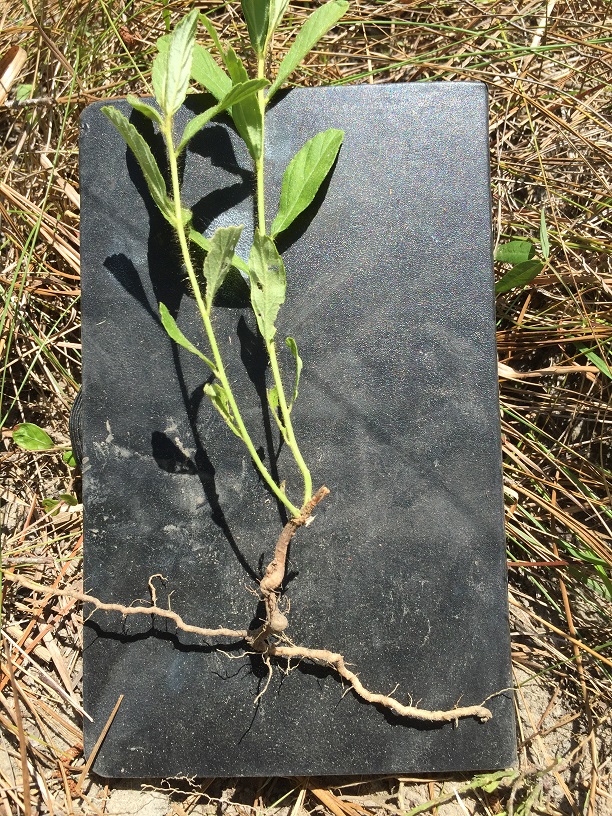Difference between revisions of "Piriqueta cistoides"
(→References and notes) |
(→Photo Gallery) |
||
| Line 48: | Line 48: | ||
==Photo Gallery== | ==Photo Gallery== | ||
<gallery widths=180px> | <gallery widths=180px> | ||
| + | File:Piriqueta cistoides (1).jpg| <center> ''Piriqueta cistoides'' root <p> Photo by Kevin Robertson </p> <p>Pebble Hill Plantation</p> <p>2015</p> | ||
</gallery> | </gallery> | ||
Revision as of 11:12, 21 April 2016
| Piriqueta cistoides | |
|---|---|

| |
| Photo taken by Michelle M. Smith | |
| Scientific classification | |
| Kingdom: | Plantae |
| Division: | Magnoliophyta - Flowering plants |
| Class: | Magnoliopsida – Dicotyledons |
| Order: | Violales |
| Family: | Passifloraceae |
| Genus: | Piriqueta |
| Species: | P. cistoides |
| Binomial name | |
| Piriqueta cistoides (L.) Griseb. | |

| |
| Natural range of Piriqueta cistoides from USDA NRCS Plants Database. | |
Common name: pitted stripeseed
Contents
Taxonomic notes
Synonym: Piriqueta cistoides ssp. cistoides
Description
"Perennial herb, 1.5-5 dm tall, forming colonies by root sprouts, stem pubescence densely stellate, admixed with long, spreading trichomes. Leaves alternate, oblong to lanceolate, 2.5-5 cm long, 0.5 -1.7 cm wide, finely stellate pubescent on both surfaces with long trichomes on the midrib below, obtuse, rarely acute, base rounded to attenuate, sessile or petioles to 2 mm long. Inflorescence a terminal bracteate raceme; pedicels equaling or shorter than the peduncles. Calyx 5 parted, 5-8 mm long; petals 5, brilliant orange-yellow, 1.5-2 cm long; stamens 5, shorter than the petals; pistil 3- parted, stigmas brush-like capsule 3-valved, 1-celled, globose, 5-7 mm long. Seeds tan or blackish gray, obovate, 1.8-2 mm long, ribbed, arillate." [1]
Distribution
Ecology
Habitat
Natural habitats include open upland pine woodland; well drained longleaf pineland; scattered on slopes and ridges in a longleaf pine forest; recently burned sandhill; and longleaf, wiregrass habitat (FSU Herbarium). It has also been documented to occur along powerline corridors. It has been observed to grow in drying loamy sand (FSU Herbarium). Associated species include longleaf pine and wiregrass (FSU Herbarium).
Phenology
P. cistoides has been observed to bloom in August (FSU Herbarium). Kevin Robertson has observed this species flower within three months of burning. KMR
Seed dispersal
According to Kay Kirkman, a plant ecologist, this species disperses by explosion mechanisms or by ants. [2]
Pollination
The following Hymenoptera families and species were observed visiting flowers of Piriqueta cistoides at Archbold Biological Station (Deyrup 2015):
Halictidae: Augochlorella aurata, Augochloropsis metallica, Lasioglossum nymphalis
Conservation and Management
Cultivation and restoration
Photo Gallery
References and notes
Deyrup, M.A. and N.D. 2015. Database of observations of Hymenoptera visitations to flowers of plants on Archbold Biological Station, Florida, USA.
Florida State University Robert K. Godfrey Herbarium database. URL: http://herbarium.bio.fsu.edu. Last accessed: July 2015. Collectors: Loran C. Anderson, R. A. Norris, Kevin Oakes, Robert K. Godfrey, R. Komarek, Cecil R Slaughter. States and Counties: Florida: Duval, Gadsden, Leon, Wakulla. Georgia: Grady, Thomas. Compiled by Tall Timbers Research Station and Land Conservancy.
